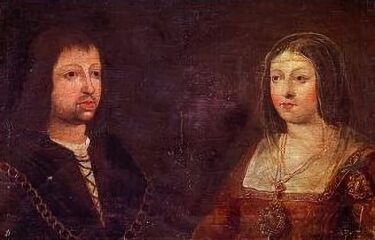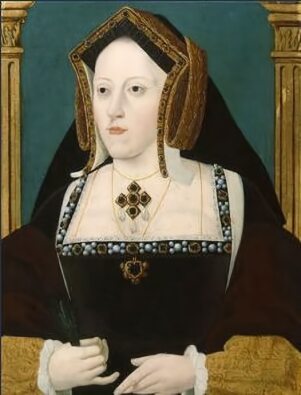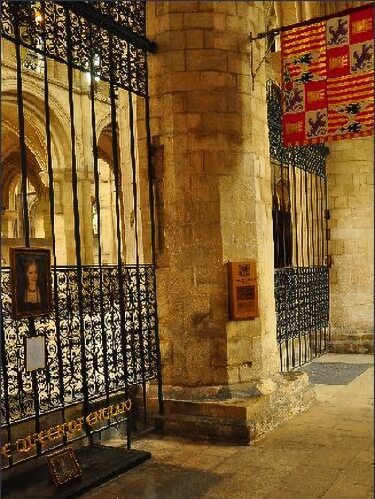1485- 1536 Early life
Catherine of Aragon was born at Laredo Palace in Alcalá de Henares on 16th October 1485, the youngest surviving child of Ferdinand II of Aragon and Isabella I of Castile, whose marriage had united Spain under one rule. Through her mother Isabella, she was twice descended from Edward III of England, through his fourth son, John of Gaunt, Duke of Lancaster. The Spanish princess's namesake and maternal great-grandmother had been Catherine of Lancaster, John of Gaunt's daughter. Her 2 greats grandmother had been another of John of Gaunt's daughters, Phillipa, Queen of Portugal.
Catherine of Aragon
The young Infanta Catherine was betrothed at an early age to Arthur, Prince of Wales, the eldest son of Henry VII and Elizabeth of York and heir to the English throne. Henry VII had been haggling with Ferdinand and Isabella for some time regarding the terms of the arranged marriage. The main bones of contention being the dowry she would receive and the two fathers deep distrust of each other, based on previous experience. A final marriage treaty was arrived in October 1496, after which a proxy marriage took place.
Ferdinand and Isabella of Spain
Marriage to Arthur, Prince of Wales
The couple were considered of an age to marry in 1501, and Catherine, at the age of fifteen, embarked on the journey to England. After an arduous voyage she finally reached her destination on 4 November, 1501, meeting her future husband and his father for the first time at Dogsmersfield Palace in Hampshire and was recieved with much rejoicing.
Catherine, as a young girl was highly attractive, with long red-gold hair and a healthy complexion. Though fairly short and plump, her bearing was described as regal. Her voice was said to be low and resounding,
Arthur later wrote to Ferdinand and Isabella that he was immensely happy to behold the face of his lovely bride. They were married ten days later, at St. Paul's Cathedral on 14 November 1501. The bride was given away by Arthur's ebullient ten-year-old brother, Henry, Duke of York. There were feasts, jousts and disguisings to celebrate the event. Even the parsimonious Henry, always inclined to be very frugal with money, spent lavishly on the celebrations. The 'upstart' Tudor dynasty gained much in prestige from its new-forged links with the powerful House of Trastamara.
Arthur and Catherine were sent to Ludlow, in the Welsh Marches, traditionally the seat of the Prince of Wales. During the spring, an epidemic of sweating sickness was rife in the area and both Arthur and Catherine contracted it. Catherine recovered, but Arthur, a pale thin youth who had never enjoyed robust health, did not and died at Ludlow Castle.
Prince Arthur
New disputes arose between Henry VII and Ferdinand of Aragon, who still could not bring themselves to trust each other. Since his daughter was now widowed, Ferdinand wished to be reimbursed for the first instalment of her dowry. Henry, on the other hand, having got the money, was singularly inclined not to part with it and inflamed the situation further by promptly demanding the rest of it.
Less than a year after the death of Arthur, Elizabeth of York, a kind and benevolent figure in Catherine's new home, died in childbirth while attempting to secure the Tudor succession. Henry VII suggested that he should marry Catherine himself. This proposal met with an icy response from Isabella, 'It would be an evil thing,' she wrote 'the mere mention of which offends the ears'.
Agreement was finally reached that Catherine should marry the young Prince Henry, the new heir to the throne. Even this arrangement did not run smoothly, Henry and Ferdinand continued to haggle endlessly about money, while Catherine was forced to live in near penury, writing appeals to her father for money. The death of Elizabeth of York was followed shortly after by that of Catherine's mother, Isabella of Castille. Catherine had revered her mother, the event also lessened her importance in the royal marriage stakes.
Marriage to Henry VIII
King Henry VIII ascended the throne on the death of his father in April 1509. All objections to his marriage with Catherine were slung aside. The couple were married on 11th June 1509. Queen Catherine gave birth to a son, named Henry, at Greenwich Palace on 1st January 1511 who was created Duke of Cornwall. In tournaments celebrating the event the extrovert King competed as 'Sir Loyal Heart', tragically, the child died just a few weeks later. Catherine was to experience many still-births and miscarriages before producing the only surviving child of the marriage, a daughter, Mary, born in 1516. Henry doted on the child and loved to show her off to courtiers, but desperately wanted a male heir, without which, he felt, England would fall back into the Anarchy of the Wars of the Roses.
In 1527 Henry became hopelessly infatuated with Anne Boleyn, a young woman of the court. Anne had large, lustrous brown eyes and raven hair, combined with a stylish way of dressing and enchanting French ways acquired during her stay at the court of Francis I. Her sister, Mary Boleyn, had previously been the king's mistress but he had now grown tired of her and cast her off. The ambitious Anne refused to become his mistress and held out for marriage.
Catherine of Aragon in later life
Henry's conscience, always a very pliable instrument, conveniently came into play. He claimed to be troubled by a verse in Leviticus stating it was sinful for a man to take his brother's wife and as punishment, any such transgressor would be childless. He persuaded himself that this was why God had denied him a male heir by his marriage to Catherine.
Lead on by the resolute Anne, now determined to become Queen, Henry resolved that he would divorce Catherine. Catherine, however, refused to comply and acquired the considerable support of her powerful nephew, Charles V, Holy Roman Emperor and King of Spain. The Pope, caught in Charles' power, could not gratify Henry's desire for an annulment. Despite the strenuous efforts of Wolsey, "The Kings Great Matter" as it came to be referred to, dragged on for many years.
Henry, characteristically furious and frustrated at not obtaining his way, defied the Pope, setting himself up as head of the Church of England, a church that was Catholic in doctrine but divorced from the "Bishop of Rome".
Tomb of Catherine of Aragon at Peterborough Cathedral
Matters had now to proceed swiftly, as Anne had announced herself pregnant and Henry was determined that the child, whom he ardently convinced himself would be the longed-for son, should be born in lawful matrimony. Thomas Cranmer, Archbishop of Canterbury, a man of decidedly Protestant leanings, performed the marriage service.
Final years
Henry's marriage to Catherine was declared null and void. Catherine's daughter, the Lady Mary, suffered deprivations and the humiliation of being publicly declared a bastard, she was denied access to her mother, although they continued to correspond in secret. Until her death, Catherine continued to stubbornly refer to herself as Henry's only lawful wife. In 1535 Henry had her transferred to Kimbolton Castle in Huntington. By late December 1535, it was clear that Catherine was dying, she wrote a final letter to Henry, which was affectionate but defiant in its tone:-
My most dear lord, king and husband,
The hour of my death now drawing on, the tender love I owe you forceth me, my case being such, to commend myself to you, and to put you in remembrance with a few words of the health and safeguard of your soul which you ought to prefer before all worldly matters, and before the care and pampering of your body, for the which you have cast me into many calamities and yourself into many troubles. For my part, I pardon you everything, and I wish to devoutly pray to God that He will pardon you also. For the rest, I commend unto you our daughter Mary, beseeching you to be a good father unto her, as I have heretofore desired. I entreat you also, on behalf of my maids, to give them marriage portions, which is not much, they being but three. For all my other servants I solicit the wages due them, and a year more, lest they be unprovided for. Lastly, I make this vow, that mine eyes desire you above all things.
Catherine of Aragon died at Kimbolton Castle, on 7 January 1536, probably of cancer, three weeks after her fiftieth birthday. She was buried in Peterborough Cathedral with the ceremony due to a Princess Dowager of Wales and Arthur's widow but not as a Queen of England. Henry himself displayed no sorrow at her death and gave thanks there was now no fear of war with Catherine's nephew, Emperor Charles V.
Six wives of Henry VIII PreviousNext Anne Boleyn
